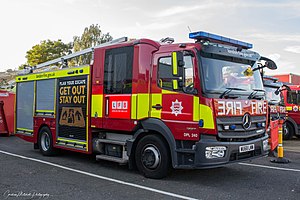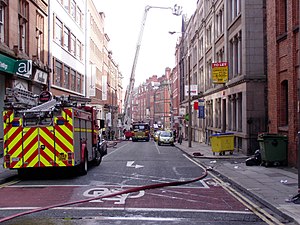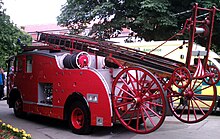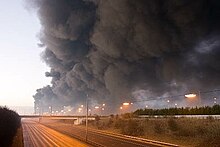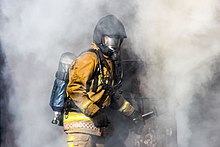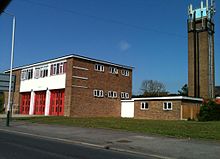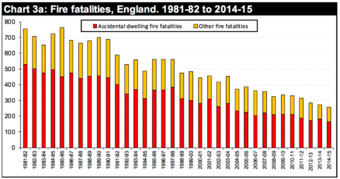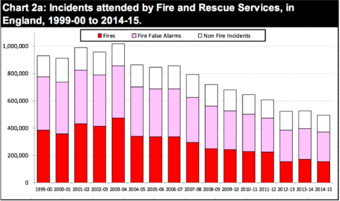
The New South Wales Rural Fire Service is a volunteer-based firefighting agency and statutory body of the Government of New South Wales.

The London Fire Brigade (LFB) is the fire and rescue service for London, the capital of the United Kingdom. It was formed by the Metropolitan Fire Brigade Act 1865, under the leadership of superintendent Eyre Massey Shaw. It has 5,992 staff, including 5,096 operational firefighters and officers based at 102 fire stations.
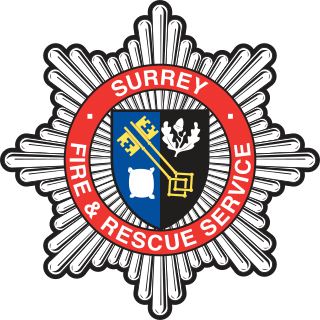
The Surrey Fire and Rescue Service is the statutory fire and rescue service for the County of Surrey, England, with 25 fire stations. It comes under the administrative and legislative control of Surrey County Council, acting as the fire authority who fund the service by collecting a precept via council tax, and from central government funds, known as a grant settlement, and provide the political leadership for the service.
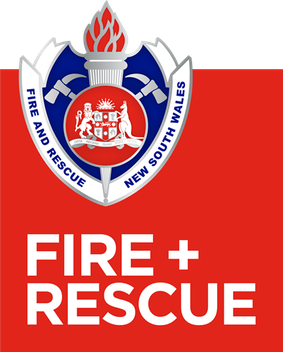
Fire and Rescue NSW (FRNSW) previously known as NSW Fire Brigades (NSWFB), is an agency of the Government of New South Wales, Australia. FRNSW is responsible for firefighting, rescue and HazMat services in the major cities, metropolitan areas and towns across New South Wales. Fire and Rescue NSW is the fourth largest urban fire service in the world, with over 6,800 firefighters serving at 335 fire stations throughout the state, supported by 465 administrative and trades staff and 5,700 community fire unit volunteers. FRNSW are the busiest fire service in Australia, attending over 124,000 incidents a year.
Chief fire officer (CFO), formerly often just chief officer or county fire officer, is the highest rank in the fire and rescue services of the United Kingdom. There are currently 50 chief fire officers serving in the United Kingdom in charge of the local authority fire services. There is also a chief fire officer responsible for the Ministry of Defence Fire Services, which includes the Defence Fire and Rescue Service and the RAF Fire Service. Some UK airport fire services also designate their seniors officers as CFOs, though these officers rarely wear the same rank insignia as a local authority chief fire officer.
As firefighting has a rich history throughout the world, traditions in this profession vary widely from country to country.

Merseyside Fire and Rescue Service is the statutory fire and rescue service covering the county of Merseyside in north-west England and is the statutory Fire and Rescue Authority responsible for all 999 fire brigade calls in Sefton, Knowsley, St. Helens, Liverpool and Wirral.
FiReControl was a project, initiated in the United Kingdom in March 2004, to reduce the number of control rooms used to handle emergency calls for fire services and authorities. Presently there are 46 control rooms in England that handle calls from the local public for emergency assistance via the 999 system. A new radio network – FireLink – is being developed and built that will be compatible with FiReControl.
The Independent Review of the Fire Service, sometimes referred to as the Bain Report or IRFS was a wide-ranging report carried out by Professor Sir George Bain, in 2002, at the request of the government, into the how Fire and Rescue Services were operated and managed; and about the working conditions of firefighters in the UK. When the report was completed, its full title was The Future of the Fire Service: reducing risk, saving lives - The Independent Review of the Fire Service , although it is generally known by the shortened name. On publication, its authors said the report: "sets out our recommendations for how the service should change in the future to meet the demands of the twenty-first century." The report prompted a prolonged period of industrial action in the UK by firefighters, the first national strike since 1977. The Bain report made several recommendations, that led to wide ranging changes in the approach to fire and rescue authorities (FRS) in the UK. It was controversial because of its extensive scope, and in 2006, many changes to UK FRS continue as a direct result of it.

Kent Fire and Rescue Service is the statutory fire and rescue service for the administrative county of Kent and the unitary authority area of Medway, covering a geographical area south-east of London, to the coast and including major shipping routes via the Thames and Medway rivers. The total coastline covered is 225 km ; it has 55 fire stations, and four district fire safety offices. The FRS provides emergency cover to a population of nearly 2 million.

The Fire Services Act 1947 was an Act of Parliament of the United Kingdom that reorganised fire services in the United Kingdom. It disbanded the National Fire Service and returned the responsibility for running fire services to local authorities.

North Yorkshire Fire & Rescue Service is the statutory fire and rescue service covering the area of the unitary authorities of North Yorkshire and the City of York. The service covers an area of 3,209 square miles (8,310 km2) and serves a population of 830,000. It is divided into eight groups related to the above districts.

The history of fire brigades in the United Kingdom charts the development of fire services in the United Kingdom from the creation of the United Kingdom to the present day.
The history of fire safety legislation in the United Kingdom formally covers the period from the formation of the United Kingdom of Great Britain and Ireland in 1801 but is founded in the history of such legislation in England and Wales, and Scotland before 1708, and that of the Kingdom of Great Britain from 1707 to 1800.

The Mid and West Wales Fire and Rescue Service is the fire and rescue service covering the Welsh principal areas of Carmarthenshire, Ceredigion, Neath Port Talbot, Pembrokeshire, Powys and Swansea.
In the United Kingdom and Ireland, a retained firefighter, also known as an RDS firefighter or on-call firefighter, is a firefighter who does not work on a fire station full-time but is paid to spend long periods of time on call to respond to emergencies through the Retained Duty System. Many have full-time jobs outside the fire service. Retained firefighters are employed and trained by the local fire and rescue service.

Cornwall Fire and Rescue Service is the statutory fire and rescue service covering Cornwall, England. As of April 2019, the service employs over 400 retained firefighters, 203 full-time firefighters, plus 170 support and administrative staff. Created under the Fire Services Act 1947 as "Cornwall County Fire Brigade", the name changed to "Cornwall Fire and Rescue Service" on 1 October 2009.

Sir Kenneth John Knight, is a retired British firefighter and public servant. From 2003 to 2007, he was the Commissioner of the London Fire Brigade and Commissioner for the London Fire and Emergency Planning Authority. From 2007 to 2013, he was the Chief Fire and Rescue Adviser for England.

Tyne and Wear Fire and Rescue Service, formerly known as the Tyne and Wear Metropolitan Fire Brigade, is the fire and rescue service (FRS) for the metropolitan boroughs of Newcastle Upon Tyne, Gateshead, North Tyneside, South Tyneside and Sunderland, serving a population of 1.14 million people across an area of 208 square miles (540 km2). Tyne and Wear Fire and Rescue Authority is responsible for the running of the service, as well as the publication of performance indicators in accordance with its legal obligations. In May 2023,Peter Heath was appointed chief fire officer.

The Scottish Fire and Rescue Service is the national fire and rescue service of Scotland. It was formed by the merger of eight regional fire services in the country on 1 April 2013. It thus became the largest fire brigade in the United Kingdom, surpassing the London Fire Brigade.
